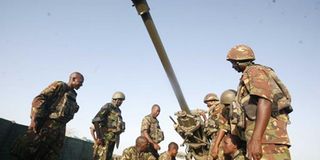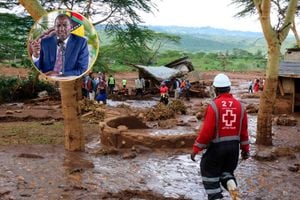It’s not yet too late for KDF troops to leave Somalia to promote peace there

Kenya Defence Forces soldiers attached to Amisom at Afmadow Military Camp in Somalia on January 23, 2014. FILE PHOTO | EVANS HABIL |
What you need to know:
- This “occupation” could have far-reaching negative consequences.
- It is still not too late for Kenya to withdraw its forces from Somalia.
No one can doubt that Kenya is failing miserably in its counter-terrorism efforts.
From Westgate to Mandera and Garissa, the death toll of Kenyan civilians killed by Al-Shabaab has now risen to more than 600.
Apart from corruption within both the security and immigration services, which are now widely recognised as key facilitators of terrorists, blame can also be placed on senior government officials and corrupt brokers who pocketed millions of shillings through fake contracts that failed to deliver strategically important security equipment to Kenya.
We could say that Anglo Leasing and other scams paved the way for the terrorism that we are now witnessing.
However, Kenya’s failure to stem the threat posed by Al-Shabaab is also the result of strategic and tactical mistakes made by the Kenyan Government and the military.
The first of these mistakes was to invade Somalia in October 2011, which defied the international peacekeeping rule of countries sharing a common border not militarily intervening in one another’s territory. This rule prevents conflict of interest and border disputes that could lead to more instability.
Ethiopia ignored this rule in 2006 when it ousted the Islamic Courts Union from Mogadishu and stayed in Somalia for two years until it was forced out by Al-Shabaab, the extremist stepchild of the ICU that was gaining strength in south and central Somalia.
This paved the way for the African Union to send in soldiers to expel Al-Shabaab from the capital. Uganda and Burundi were the first countries to offer their troops.
WITHOUT CONSULTATION
Strangely, Kenya, instead of offering its troops to the African Union Mission in Somalia (Amisom), decided to go it alone. Warmongers in the Mwai Kibaki administration believed that in order to secure a safe “buffer zone” between Kenya and Somalia, Kenya needed to oust Al-Shabaab from southern Somalia and take control of the port of Kismayu, the group’s economic lifeline.
This decision was made without any prior consultation with the Kenyan people or even their elected representatives in Parliament.
On the face of it, Operation Linda Nchi sounded like a good idea, but there were fatal mistakes made along the way. The first of these, supported by Igad and the United States, was for the Kenya Defence Forces to train Somalis for their national army.
Apparently, the youth who ended up getting military training were not Somali nationals, but Kenyan Somalis. Many of these youth abandoned their training due to poor remuneration and some deserted the Kenyan army during its mission in Somalia.
It is believed that many are now selling their military services to the highest bidder, including Al-Shabaab. Kenya thus inadvertently created insecurity within its own borders.
AWKWARD POSITION
The second mistake was to link up with Ahmed Madobe’s Ras Kamboni militia. While there were probably sound reasons to partner with a group that knew the terrain well and which had insider knowledge of Al-Shabaab, given that Madobe was once linked to this terrorist group, this partnership added to the perception that the Kenyan invasion and subsequent “occupation” were attempts to instal a puppet government in Jubbaland dominated by Madobe’s Ogaden clan, which also happens to be politically influential in northeastern Kenya.
The recent stand-off between Madobe’s interim administration in Jubbaland and the Federal Government of Somalia in Mogadishu now puts Kenyan troops in the awkward position of being allied to the former but mandated to protect the latter.
Meanwhile, Ethiopian troops have also joined Amisom and are now controlling the Gedo region that borders both Kenya and Ethiopia. Thus, two frontline states that should have never militarily intervened in Somalia are now being viewed as occupying forces by most Somalis. This “occupation” could have far-reaching negative consequences.
Meanwhile, allegations of Kenyan forces illegally exporting charcoal from Kismayu are causing increasing resentment and suspicion among Somalis.
It is still not too late for Kenya to withdraw its forces from Somalia. This will help the country gain the trust of the Somali people and improve its moral standing in international efforts to promote stability in this war-torn country.





